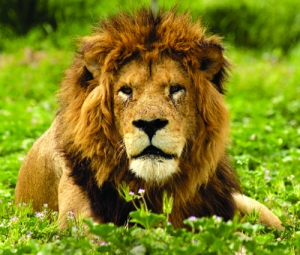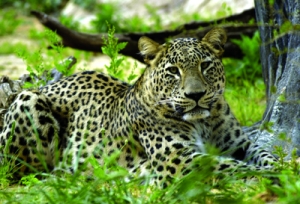|
ZOOS
Oasis in the City
The Zoological Center of Tel Aviv-Ramat
Gan (Safari) has recreated an African savannah in the most densely
populated part of Israel. by Heidi J. Gleit
When thinking about
Tel Aviv and Ramat Gan, which are in the center of the most densely
populated part of Israel, many people picture modern skyscrapers, huge
highways clogged with cars and trucks, and crowds of people. The last
thing that most people would expect to find in the middle of this urban
jungle is an open, natural area where zebra, antelopes, and hippos roam
and interact.
The Zoological
Center (Safari) of Tel Aviv-Ramat Gan has recreated an African savannah
in the Ramat Gan National Park. The largest zoo in the Middle East
houses some 1,600 animals, representing over 200 species on a 250-acre
park and hosts about half a million guests annually. The gardens and
animal enclosures of a zoo that visitors can walk through covers about
45 acres. The rest is an African park in which several hundred animals
live in conditions similar to their natural habitats. One of the unique
aspects of the Safari is that a wide variety of species share the same
area and can be seen interacting the way they would in the wild, Safari
Curator Dr. Amelia Terkel explained.

(Tibor
Yager, courtesy of the Zoological Center Tel Aviv-Ramat Gan-Safari)
“If you have
patience, you can see anything here,” she added.
A two-lane road
winds through the open land of the Safari so that visitors can observe
the animals. You can drive along the road in your own car or ride
through part of it on the safari train. The train only operates during
peak season, so reservations are required. Private train rides also can
be arranged for groups. Plan for a visit to the Safari to take at least
three hours. Refreshments can be purchased at the restaurant and enjoyed
on a veranda overlooking the gibbon island and a pool with pelicans.
Building a Zoo
In the 1960s, the
manager of the national park, Zvi Kirmeier, and Ramat Gan Mayor Abraham
Krinitzi decided to expand the park’s small zoo. They contacted a
wildlife agent in Kenya and began to investigate possibilities. After
Krinitzi’s death, his successor, Dr. Israel Peled, enthusiastically
continued to work with Kirmeier on the plan. They even went on a safari
in Africa to collect animals for the park. They returned from their
expedition with 17 animals and a contract for 200 additional animals to
be brought to Israel. In 1973, the animals arrived and the safari opened
in 1974.
Five years later,
the Tel Aviv municipality decided to relocate the municipal zoo, which
was located in the city center, just under the city hall. The planning
commission contacted the Safari and a decision was made to merge the two
by building facilities for a zoo in the middle of the African park. The
zoo opened in 1981 and has been developing ever since.
“We are constantly
taking steps to improve the zoo,” Terkel said. “Our vision is to get all
the animals out of cages. We have been working for a while to change to
open, more natural enclosures. Our progress is largely dependent on
funding.”

(Tibor
Yager, courtesy of the Zoological Center Tel Aviv-Ramat Gan-Safari)
New more natural
enclosures opened recently for the leopard, honey badgers, and
cockatoos. Work is progressing on new enclosures for additional birds
and for reptiles.
Native Israelis
The zoo section is
home to many animals that are native to Israel and the Middle East,
especially endangered species. One example is the sand cat (Felis
margarita), a wild cat that is native to the Arava and Jordan. It looks
so much like a street cat that it is surprising to see one in the zoo.
However, since the sand cat is an endangered species the Safari is
breeding them in cooperation with the Israel Zoo Association and the
Israel Nature and Parks Authority (INPA). They hope to reintroduce the
cats to the wild. The feasibility of doing so is under investigation,
Terkel explained. She noted that the fox and red wolf population in the
Arava has grown so significantly that it may not be safe to return the
small cats to their natural habitat...
One of the most
interesting animals to observe is the honey badger (Mellivora capensis),
whose natural habitat extends from South Africa to northern Israel...
Well-Adjusted Immigrants
The Safari also has
animals from other parts of the world, including a family of gorillas
and two herds of elephants. Surprising as it may be, the elephants have
adapted well to the Israeli climate. So many have been born at the
Safari that there wasn’t room for them all and Israeli-born elephants
can now be found at zoos worldwide...
The Safari also has
South American and Australian sections. The Australian section is
designed to be especially fun for children, with rope bridges and
structures to climb on.
For the Birds
Bird-lovers will
find much to praise at the Safari...
The full
article
appeared in ERETZ Magazine 105. To read it, subscribe to ERETZ Magazine. |

